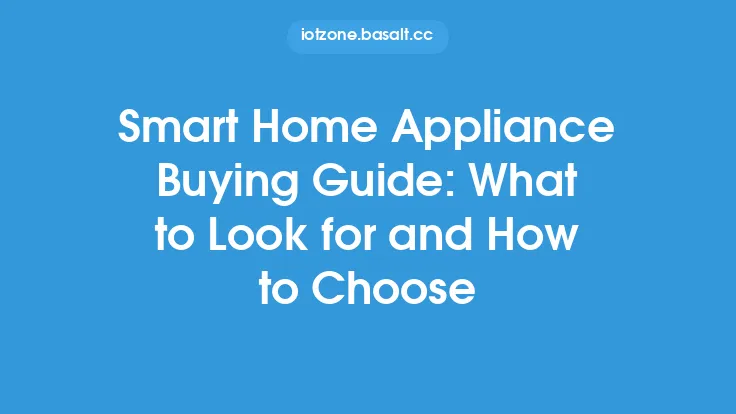Getting started with smart home devices can be a daunting task, especially for those who are new to the world of smart home automation. With so many different devices and brands available, it can be difficult to know where to begin. In this article, we will provide a comprehensive overview of smart home devices, including their features, benefits, and some of the most popular brands.
Introduction to Smart Home Devices
Smart home devices are designed to make our lives easier, more convenient, and more enjoyable. These devices can be controlled remotely using a smartphone or tablet, and can be integrated with other devices to create a seamless and connected experience. Some common examples of smart home devices include smart thermostats, smart lighting systems, smart security cameras, and smart speakers. These devices can be used to control the temperature, lighting, and security of a home, as well as provide entertainment and information.
Features of Smart Home Devices
Smart home devices have a wide range of features that make them useful and convenient. Some common features of smart home devices include:
- Remote control: Smart home devices can be controlled remotely using a smartphone or tablet, allowing users to adjust settings and monitor their home from anywhere.
- Voice control: Many smart home devices can be controlled using voice commands, making it easy to adjust settings without having to physically interact with the device.
- Scheduling: Smart home devices can be scheduled to turn on and off at specific times, making it easy to automate routine tasks.
- Energy monitoring: Some smart home devices can monitor energy usage, providing users with valuable insights into their energy consumption.
- Integration: Smart home devices can be integrated with other devices, creating a seamless and connected experience.
Benefits of Smart Home Devices
Smart home devices have a wide range of benefits that make them a worthwhile investment. Some of the most significant benefits of smart home devices include:
- Convenience: Smart home devices make it easy to control and monitor a home, providing users with a convenient and hassle-free experience.
- Energy efficiency: Smart home devices can help users reduce their energy consumption, saving them money on their utility bills.
- Increased security: Smart home devices can provide users with an added layer of security, making it easier to monitor and protect their home.
- Enhanced entertainment: Smart home devices can provide users with a wide range of entertainment options, making it easy to enjoy music, movies, and other forms of entertainment.
- Improved comfort: Smart home devices can help users create a comfortable and relaxing living space, making it easy to adjust the temperature, lighting, and other settings to suit their needs.
Popular Smart Home Device Brands
There are many different brands of smart home devices available, each with their own unique features and benefits. Some of the most popular smart home device brands include:
- Amazon: Amazon offers a wide range of smart home devices, including the popular Echo smart speaker and the Ring smart doorbell.
- Google: Google offers a range of smart home devices, including the Google Home smart speaker and the Nest smart thermostat.
- Apple: Apple offers a range of smart home devices, including the HomePod smart speaker and the Apple TV streaming device.
- Samsung: Samsung offers a range of smart home devices, including the SmartThings hub and the Samsung Smart TV.
- Philips: Philips offers a range of smart home devices, including the Philips Hue smart lighting system and the Philips Smart TV.
Smart Home Device Protocols and Standards
Smart home devices use a variety of protocols and standards to communicate with each other and with the internet. Some of the most common protocols and standards used in smart home devices include:
- Wi-Fi: Wi-Fi is a popular protocol used in smart home devices, providing a fast and reliable connection to the internet.
- Bluetooth: Bluetooth is a protocol used in some smart home devices, providing a low-power and low-cost connection to other devices.
- Zigbee: Zigbee is a protocol used in some smart home devices, providing a low-power and low-cost connection to other devices.
- Z-Wave: Z-Wave is a protocol used in some smart home devices, providing a low-power and low-cost connection to other devices.
- Thread: Thread is a protocol used in some smart home devices, providing a low-power and low-cost connection to other devices.
Smart Home Device Security
Smart home devices can be vulnerable to security risks, making it important to take steps to protect them. Some common security risks associated with smart home devices include:
- Hacking: Smart home devices can be hacked, allowing unauthorized access to the device and the home network.
- Data breaches: Smart home devices can be vulnerable to data breaches, allowing unauthorized access to sensitive information.
- Malware: Smart home devices can be infected with malware, allowing unauthorized access to the device and the home network.
To protect smart home devices from these security risks, it is important to take steps such as:
- Changing default passwords: Changing the default password on a smart home device can help prevent unauthorized access.
- Keeping software up to date: Keeping the software on a smart home device up to date can help patch security vulnerabilities.
- Using a secure network: Using a secure network, such as a virtual private network (VPN), can help protect smart home devices from security risks.
Conclusion
Smart home devices are a convenient and useful way to control and monitor a home. With a wide range of features and benefits, smart home devices can make life easier, more convenient, and more enjoyable. By understanding the different types of smart home devices, their features and benefits, and the popular brands available, users can make informed decisions about which devices to use in their home. Additionally, by taking steps to protect smart home devices from security risks, users can help ensure a safe and secure smart home experience.





